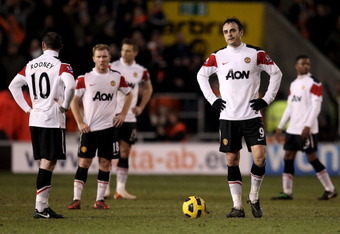
Courtesy of Travis Clark from MLSsoccer.com
As the complexion of youth development in MLS and the United States continues to evolve, the role of college soccer goes along with it. And while the role of the collegiate program will be debated down the road, given the size of the United States, players will most likely always emerge from the college system.
Over the course of 15 MLS seasons, two college programs stand above the rest when it comes to contributing professionals: UCLA and Virginia. According to the league, 54 players have emerged from UCLA school, while 41 came out of UVA. (NOTE: For the purposes of this article, 2011 MLS draft picks were not included in the numbers because it is still unclear which draftees will actually make a squad.)
However, despite the two schools’ rich history of player production over the years, no Bruins or Cavaliers were selected in the 2011 draft. According to current UCLA coach Jorge Salcedo, a couple of his players were candidates for the latest Generation adidas class, but none eventually signed a contract.
Salcedo attributes the success of UCLA to the platform originally built by current Seattle Sounders FC coach Sigi Schmid, who spent nearly two decades in charge of the Bruins soccer team from 1980 to 1999. During that time, he won three NCAA championships and helped develop eventual many US internationals and pros, including Brad Friedel, Cobi Jones, Carlos Bocanegra, Frankie Hejduk, and Eddie Lewis, among others.
Top MLS Talent-Producing Colleges all-time
| School | MLS Players |
| UCLA | 54 |
| Virginia | 41 |
| Maryland | 34 |
| Indiana | 27 |
| Clemson | 23 |
| UNC | 23 |
| Wake Forest | 20 |
| UConn | 17 |
| Santa Clara | 17 |
| Washington | 17 |
| St. Louis | 17 |
“I think there are a variety of reasons, but the number one reason is that we’ve been a successful program for many years now,” he told MLSsoccer.com. “It’s a program that Sigi Schmid, from the early ’80s into the mid ’90s, built a program where we have continued to bring in top players from Southern California and around the country.”
The story of UCLA’s success is mirrored at Virginia, with the Schmid role played by current LA Galaxy coach Bruce Arena.
Arena was at UVA from 1978 to 1995, when he left to take the reins atD.C. United in the MLS club’s inaugural year. With Virginia, Arena won five national championships, guiding such future stars as John Harkes, Claudio Reyna, Tony Meola, and Ben Olsen, into the pro ranks.
Because both handed off sterling programs to their successors, the simple buzz of UCLA and Virginia soccer helped to attract strong recruiting classes of young talent. UVA won the 2009 NCAA championship and UCLA’s 2010 recruiting class included US youth internationals Kelyn Rowe and Victor Chavez.
For those debunking the lack of games played in a college setting, Salcedo thinks that it’s positive on a personal level for rising talents to take at least a year or two and play in college. He cites the many US internationals and World Cup veterans, including everyone from Tab Ramos and Alexi Lalas to Clint Dempsey and Oguchi Onyewu, who have spent some time in the college ranks.
“So many of them used [college soccer] as a springboard to not only become a better soccer player, but to become more mature as young men, to experiencing certain things through the few years of college that are good for the rest of your lives,” he said. “To be successful professional soccer player, you have to have a maturity level and have experience not only as a soccer player but as a young man as well.”
Top MLS talent-producing colleges, since 2006
| School | MLS Players |
| UCLA | 31 |
| Maryland | 20 |
| Wake Forest | 16 |
| Indiana | 15 |
| UNC | 15 |
| Virginia | 15 |
| UConn | 12 |
| UCSB | 11 |
| Santa Clara | 11 |
| Washington | 10 |
| St. Louis | 10 |
| California | 10 |
Of late, other schools have emerged as incubators of top MLS prospects. The ACC is clearly the deepest well of talent. Along with Virginia, Maryland has developed 34 pros (3rd most), and Clemson and North Carolina have each provided 23 players (tied for 5th most). Wake Forest has developed 20 (7th most).
Disrupting the dominance of the ACC is Indiana. Under the legendary Jerry Yeagley, men’s soccer coach from 1973 to 2003, the Hoosiers produced 27 MLS pros, a number that will likely grow this year. Former IU mainstays Will Bruin, Rich Balchan and Andy Adlard were all drafted this year.
And away from the glamour conferences, Caleb Porter and Akron, the 2010 NCAA champions, have become a kind of factory for success and talent development. Already, the likes of Steve Zakuani and Teal Bunbury are thriving in the league, and seven more former Zips went in the 2011 SuperDraft, including #2 overall Darlington Nagbe to the Portland Timbers.
As MLS Academies continue to expand, going to college may not be the road most traveled by many top players in the nation in the future. However, with North America’s value of education and the size of the United States and Canada, there’s every reason to believe that these top programs will continue to be one of many paths to take and wind up as a professional in MLS.

















